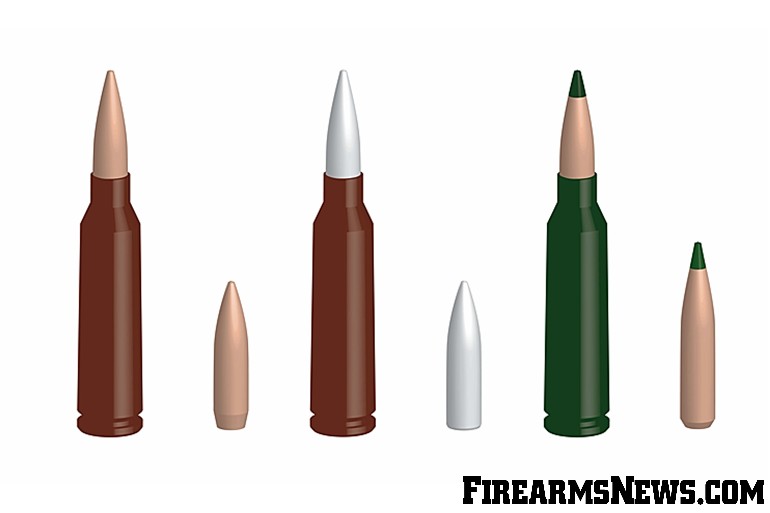
Barrel locking is achieved by more or less conventional rotary bolt. The Beretta ARX-160 assault rifle is gas operated weapon that utilizes conventional piston-operated action, with gas piston located above the barrel. There's no bolt stop device, and the bolt always goes forward when the last shot from the magazine is fired. It is slow, uncomfortable and sometimes stiff to operate ( especially when wearing gloves or mittens), and, when actuated, produces a loud and distinctive click. The safety / fire selector switch is considered by many as the main drawback of the whole AK design, which is not cured in the most of derivatives until now. The middle position is for automatic fire, and the bottom position is for single shots. In the " Safe" position (t opmost) it locks the bolt group and the trigger, and also served as a dust cover. The combined safety - fire selector switch of distinctive shape is located on the right side of the receiver. This does not affects the cyclic rate of fire, but allows the bolt group to settle in the forward most position after returning into the battery.
#5.8x42mm vs 5.56x45 full#
The AKM trigger unit also featured a hammer release delay device, which is served to delay the hammer release in the full auto fire by few microseconds. The cocking handle is permanently attached to the bolt carrier ( in fact, it forms a single machined steel unit with carrier), and does reciprocate when gun is fired. The return spring base also serves as a receiver cover lock. The return spring and a spring guide are located behind the gas piston and are partially hidden in its hollow rear part when bolt is in battery. The rotation of the bolt is ensured by the curved cam track, machined in the bolt carrier, and by the appropriate stud on the bolt itself. This results in very positive and reliable extraction even with dirty chamber and cases. Bolt is so designed that on the unlocking rotation it also makes a primary extraction movement to the fired case. The rotating bolt has two massive lugs that lock into the receiver. The bolt carrier rides on the two rails, formed on the receiver walls, with the significant clearances between the moving and stationary parts, which allows the gun to operate even when its interior is severely fouled with sand or mud. The gas chamber is located above the barrel. The gas operated action has a massive bolt carrier with a permanently attached long stroke gas piston. Both 8 meters, however, are way too optimistic for any practical use, since the effective fire is limited roughly to 300-400 meters, if not less. Another change from AK to AKM was a slightly improved rear sight, with settings from 100 to 1000 ( instead of the 800 on AK) meters. This silencer requires a special, sub-sonic ammunition with heavier bullets to be used. The compensator could be replaced by the screw-on " PBS-1 noiseless firing device", generally known as a silencer.

This spoon-like compensator is screwed onto the muzzle and utilized the muzzle blast to reduce muzzle climb during the automatic fire. Other changes were the redesigned, slightly raised buttstock and the pistol grip, and the addition of the removable muzzle flip compensator. The key changes in AKM, as compared to AK, were the introduction of the stamped steel receiver instead of the milled one, and improved trigger/hammer unit, with added hammer release delay device ( often incorrectly referred as a rate reducer). The AK-46 was gas operated, rotary bolt weapon that utilized short-stroke gas piston above the barrel, and two-part receiver with separate trigger unit housing and dual controls ( separate safety and fire selector switches on the left side of the trigger unit). In November of 1946 the AK-46 project was chosen for prototype manufacture along with 5 other projects ( out of 16 submitted to commission), and Kalashnikov was sent to the city of Kovrov ( also not far from the Moscow), to manufacture his weapon at the small arms factory there. This carbine, while not successful by itself, served as a starting point for the first Kalashnikov's assault rifle, provisionally known as AK No.1 or AK-46. Here Kalashnikov designed a semi-automatic carbine,heavily influenced by American M1Garand rifle. His first weapon was rejected on the grounds of complexity, but the designer himself was assigned to the Red Army's Small Arms and Mortar Research & Proving ground( NIPSMVO) near the Moscow to continue his education and work on other weapons. Enter Mikhail Kalashnikov, the young sergeant ofSoviet tank forces, who, after being wounded in combat in 1942,designed a prototype submachine gun while on medical leave.


 0 kommentar(er)
0 kommentar(er)
